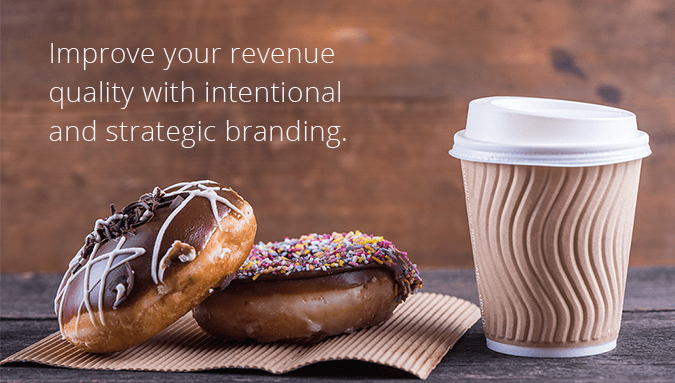Let me describe a company and see if you can guess its name. I will quickly narrow your choices by revealing that this company is what the industry calls a QSR (Quick Service Restaurants, aka a fast food place). This company has thousands of locations the world over. Customers walk up to the counter to order, they experience speedy service and either take their order to go or sit down in the restaurant. What company name comes to mind? I suspect you are thinking of McDonald’s, Burger King or some other burger place, or maybe even Subway or Chipotle. Chances are you did not think of Starbucks, even though the description above totally fits. Why is that? Because Starbucks doesn’t want you to think of them that way! They don’t view themselves as a QSR. Dunkin’ Donuts, Krispy Kreme and Tim Hortons think of themselves as a QSR, but Starbucks doesn’t. Why? Because they don’t sell donuts. More on that later.
Imagine I started a business serving people who hate to do grocery shopping, so I hire people to do the shopping and to deliver it to your home. Assuming you were interested in that service, you will probably pay me a meager amount over and above the cost of the groceries and my cost in employing people to do the work. In other words, my gross margin on that business would be paltry. Said differently, even though I might amass large revenues, passing the cost of the groceries through the revenue line, the quality of my revenue would be poor. If, in addition, my staff were to unpack the grocery bags and stock your pantry and refrigerator, you would receive more value. Further, if I were to install detectors in your pantry and refrigerator that automatically determined your supply needs, and if I gave you an app on your smartphone with your needs all filled in for you to edit, you would appreciate that value even more. With each of these additional features, I improve my quality of revenue. The quality of your revenue – best measured by the gross margin you command – is a measure of your customers’ perception of the value you provide compared to their alternatives. How good is the quality of your revenue? How can you improve the quality?
Value is created by the use of capital and the use of labor. For example, a manufacturing company uses capital to procure raw materials and uses labor to turn the raw materials into a finished product that somebody finds valuable. A warehousing company might use capital to procure a warehouse and forklifts and use labor to store and retrieve warehoused products. An accounting firm uses very little capital but has considerable use for talented labor to provide their services. During the industrial revolution, when source of capital was considerably restricted, value was created using both capital and labor. But, today, when reasonable amounts of capital is much more readily available, there is a commoditized minimal premium for value created through the use of capital. So, to create quality revenue you must create significant value through talented labor.
What the customer is willing to pay for your goods and services is a function of both the real and perceived value of your offering in comparison to the alternatives they have. For example, McDonald’s cost in providing a hamburger to a customer – including all the cost of the store, furnishings, labor, etc. – is about $1.50. Interestingly, that is about the same as the cost incurred by Starbucks in providing a customer with one of their craft coffees. Yet, McDonald’s seems to need to sell its hamburger for $2.50 while Starbucks charges almost $4.00 for its coffee. Starbucks enjoys a much higher quality of revenue than McDonald’s does.
Why is that? Because, Starbucks doesn’t sell donuts. And, if they ever do, they won’t be your ordinary glazed donut for 99 cents, intended to be bought by the dozen. Rather, they’d be craft donuts, to be devoured and savored, and sold for at least two dollars and change. Starbucks doesn’t sell coffee; they offer you a coffee experience. If that experience requires that they offer pastries, they will do so. But it is the experience that is important. McDonald’s sells you food. Starbucks offers you an experience. That brand positioning allows them to create higher quality revenue.
Having grown up in the high tech world, I have always been amazed how Dell, Cisco and Intel are all $50-60 billion dollar high tech companies, but with distinctly different quality of revenues. Dell, for the most part, neither designs nor manufactures their computers — they market and sell them. For that service, they enjoy 20% gross margin. In contrast, Cisco hires talented engineers who design advanced servers and routers, but farms out the manufacturing to Asia. They, too, market and sell their products. But, for that extra work of their talented engineers they enjoy 60% gross margin. Intel does it all – they design, manufacture, market and sell their products. It invests billions of dollars in manufacturing plants and employs people to run them in two and three shifts. For all that work, it enjoys 65% gross margin. Which of these companies enjoy high quality revenue? Clearly, both Cisco and Intel do. But Cisco seems to have figured out what creates quality in their revenue.
Quality of revenue is achieved by providing value that is unique, maintaining a perception of that value through a brand proposition that includes pricing. If you sell your products cheap, you might increase volume, but you will harm the quality of your revenue. It is a tradeoff. The same is true if you discount your products. I ran a number of electronic instrumentation businesses. These high tech instruments often sold for tens of thousands of dollars. Additionally, we would sell software that would analyze the data gathered by the instruments. The software packages would often sell for equal or higher value than the hardware, and customers would often ask for a discount. I had a simple policy: I would never discount the software; and if I felt obliged to discount the hardware, I would give some of the hardware away for free. Why is that? Nobody asks for another piece of hardware for free the next time because they know there is a real cost to manufacturing the hardware. However, they will be tempted to ask for more copies of software for free.
Quality of revenue is achieved by brand positioning (what customers think of you), product positioning (what customers think of your product) and price positioning (what customers think of your value). You must actively and intentionally manage all three. There is nothing wrong with a business like McDonald’s or Dell. If that is the nature of your business, you must be operationally excellent. However, if your business is like Starbucks or Cisco, and you want to maintain the quality of your revenues, make sure that you don’t get tempted to start selling donuts.
Originally published on ThinkShift.com









